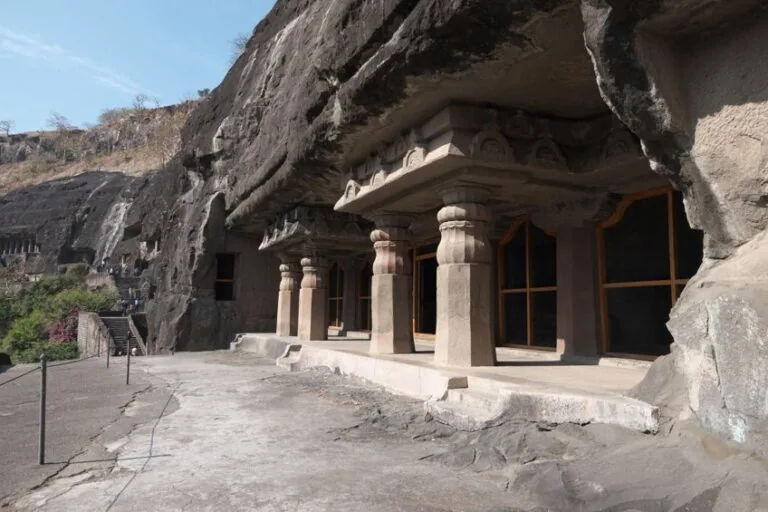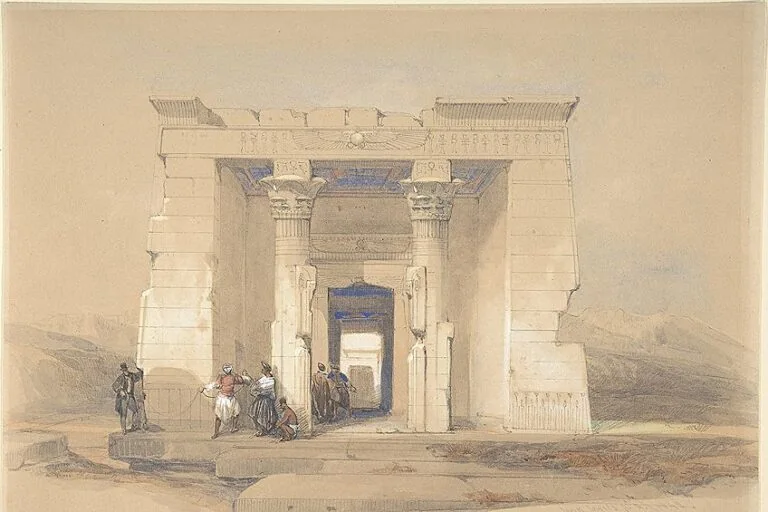Arch of Titus – Unlock the Mysteries of the Arch of Titus Inscription
The Arch of Titus is a triumphal arch that can be found in Rome. Why was the Arch of Titus built in the first place? This arch was built to commemorate the victory of Titus in the Jewish War of 66 to 74 CE. Who built the Arch of Titus though? It was built by Titus’s brother, Domitian, after his older brother’s death. So then, when was the Arch of Titus built? Construction was finished in 81 CE. What is the Arch of Titus inscription? It is a short commemoration dedicated to Titus after he was deified.
A Look at the Arch of Titus
| Architect | Rabirius (possibly) |
| Date Constructed | 81 CE |
| Function | Roman Triumphal Arch |
| Location | Via Sacra, Rome, Italy |
The Arch of Titus is a 50 ft monument dedicated to Titus Vespasian Augustus that is located along the Via Sacra, the main road through Ancient Rome. It was originally meant to be a triumphal arch celebrating Titus’s victory during the Jewish War of 66 to 74 CE, but later became part of the medieval Frangipane Fortress and fell into deterioration and disrepair. This necessitated later restoration to bring it back to a close-to-original form. The Arch of Titus is comprised of reliefs depicting Titus’s victorious celebration, and this grand arch would go on to inspire many other arches throughout history.
So, let’s take a closer look at some of the more specific information about the Arch of Titus, such as its history and inscriptions.
The History of the Arch of Titus
The Arch of Titus was constructed in 81 CE under the order of Emperor Domitian to commemorate the deification of his older brother, Titus. Deification is the process whereby a great leader of the Roman Empire was gifted a form of ascension to a divine position alongside other divine and godly beings. Titus was deemed worthy of such a glorious tribute because of his victory, alongside his father, Vespasian, over the Jewish people during the Jewish War.
The Roman Empire had quashed a Jewish rebellion in the ancient city of Jerusalem and returned home with the spoils of war.
The triumphant return of the Roman conquerors is depicted on the Arch of Titus as a means of recording the history of this event. The Arch of Titus and its carved reliefs was a means of forever immortalizing the event because history is otherwise rather quickly forgotten, and such displays were considered necessary shows of authority.
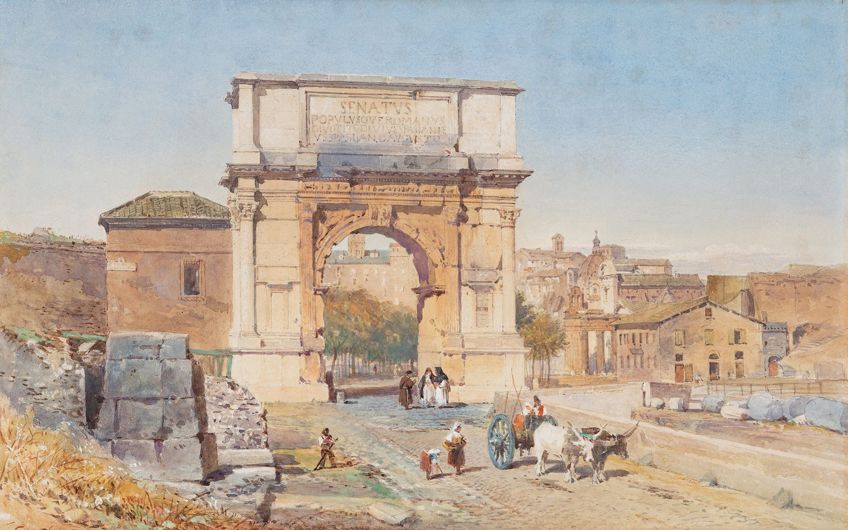 Rome: View of the Arch of Titus (c. 1859) by Henry Parsons Riviere; Creator:Henry Parsons Riviere, CC BY-SA 4.0, via Wikimedia Commons
Rome: View of the Arch of Titus (c. 1859) by Henry Parsons Riviere; Creator:Henry Parsons Riviere, CC BY-SA 4.0, via Wikimedia Commons
This authority would later deteriorate as the Arch of Titus became part of the Frangipane Fortress and fell into disrepair, but it would eventually be restored by 1821. This will be explored elsewhere in this article, but is something definitive that we know about this arch, as its architect is less definitive. The Arch of Titus was possibly designed by Domitian’s favorite architect, Rabirius, who is also considered to be a possible contender for the architect of the Colosseum. However, because of a lack of records, we cannot know this for certain.
What we can know for certain is that the Arch of Titus stood as a symbol of Roman might for centuries and remained there as a powerful indication of the conquest of Judaea. The Roman’s victory over the Jewish people had a profound influence on the history of the Jewish people too, and this conquest would persist over the Jewish people for centuries after Titus’s sacking of Jerusalem.
So, what is known about the purpose of this arch?
The Arch of Titus Inscriptions
The Arch of Titus stood as a triumphal symbol of Roman conquest, but what was actually inscribed on this gigantic structure? Why was it created? The east side of the arch contains the original Arch of Titus inscription, and it reads as follows (translated into English for the sake of convenience, but they were originally written in Roman square letters):
The Senate and the Roman people (dedicate this) to the deified Titus Vespasian Augustus, son of the deified Vespasian.
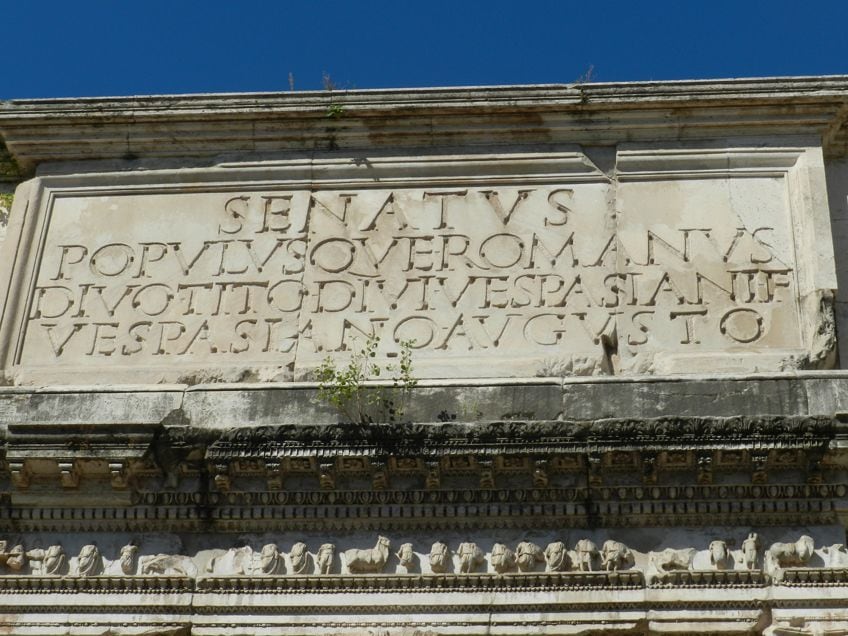 Arch of Titus, Forum Romanum, Rome, Italy (81 CE); Martin Bax, CC BY-SA 4.0, via Wikimedia Commons
Arch of Titus, Forum Romanum, Rome, Italy (81 CE); Martin Bax, CC BY-SA 4.0, via Wikimedia Commons
The inscription is rather simple but reveals the purpose for the arch’s existence. The Arch of Titus was, definitively, meant as a dedication to Titus and his deification. The iconography on the arch itself reveals more of the purpose here, but that will be discussed below.
However, despite this being the true reason for its existence, there is another inscription. When the monument was restored in 1821, the one who commissioned that restoration, Pope Pius VII, insisted that a new inscription be added to the ancient Roman arch, and that inscription reads (similarly translated into English):
(This) monument, remarkable in terms of both religion and art, had weakened from age: Pius the Seventh, Supreme Pontiff, by new works on the model of the ancient exemplar ordered it reinforced and preserved.
The Arch of Titus was restored during the pontificate of Pope Pius VII, and the Pope wanted himself immortalized alongside the existing inscription and iconography. Pius VII wished to be forever remembered beside the depiction of a great conquest, and this inscription would ensure that, but how was that great conquest depicted?
The Iconography of the Arch of Titus
The Arch of Titus is made up of reliefs that depict the triumphant return of the Roman conquerors from their war in Judaea. It features several different major reliefs. The two most prominent reliefs depict the procession of returning Roman soldiers and the other depicts Titus himself. The south inner panel’s relief depicts the procession of Roman soldiers and shows the way in which the Romans returned carrying the spoils of war from Jerusalem, especially from the Temple in Jerusalem.
The 71 CE Roman victory left Jerusalem sacked and, as a result, the relief shows Roman soldiers bringing the Gold Menorah, the Gold Trumpets, and the Table of Shewbread from the ancient Jewish city back to Rome.
The Gold Menorah is a powerful symbol of the Jewish people, and it would later be used as the emblem of the State of Israel since 1949. Such a treasure being taken from the ancient city was clearly an important and influential event that held both literal and symbolic value to the Roman conquerors and the defeated Jewish citizens of the city.
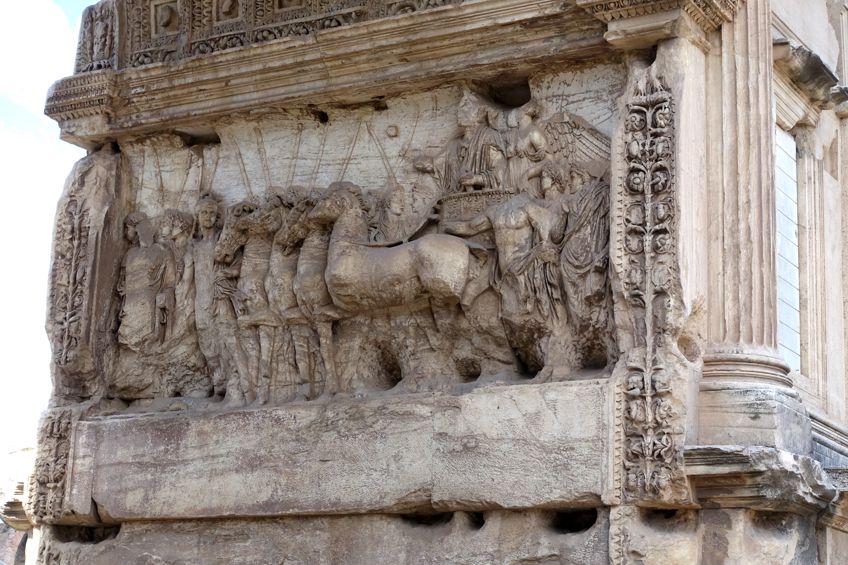 Triumph of Titus – Arch of Titus – Rome, Italy (81 CE); Daderot, Public domain, via Wikimedia Commons
Triumph of Titus – Arch of Titus – Rome, Italy (81 CE); Daderot, Public domain, via Wikimedia Commons
The opposite panel’s relief depicts the return of Titus in a chariot drawn by four horses with the Goddess of Victory at his back, as Roman citizens travel alongside him. The returning hero is surrounded by his adoring public in this detailed relief. The looting of Jewish heritage was no doubt a point of pride in such a conquest.
Interestingly, according to the 2012 Digital Restoration Project, which attempted to determine the original paint that would have covered this arch, the Menorah was likely painted gold with a blue background as yellow ochre paint was found on the Menorah relief. Additionally, the tunics would have been off-white, the wood brown, and the trumpets silver. It would not have been a plain white structure, but rather a colorful one.
It was also a structure that would go on to inspire others.
The Arch of Titus Inspired Others
The Arch of Titus was no doubt a magnificent sight because it had a profound impact on many architects in subsequent centuries. This ancient Roman structure has influenced the design of many other famous arches, for example, the Arc de Triomphe in Paris, the Washington Square Arch in New York City, and the Fusiliers’ Arch in Dublin.
Various other structures have also been influenced and will likely continue to be influenced by this gorgeous arch.
However, the architectural influence of the Arch of Titus is only part of the story. While the arch did indeed inspire many architects in their own designs, it has also stood as something of a difficult symbol for the Jewish people. This has already been briefly explored, but it is worth considering as part of the legacy of this great monument. It is true that the Arch of Titus inspired other architects, but it also represents something else.
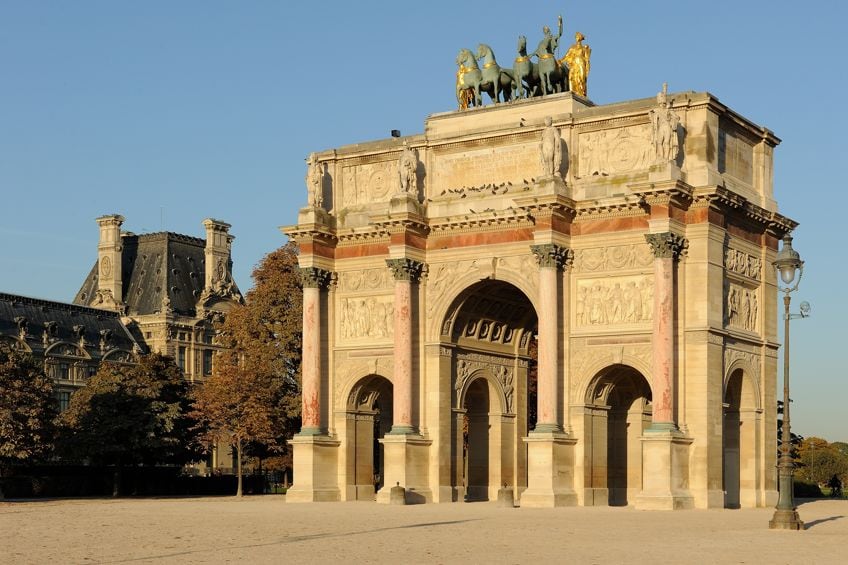 Arc de triomphe du Carrousel in Paris, France (1836); Tim Adams, CC BY 3.0, via Wikimedia Commons
Arc de triomphe du Carrousel in Paris, France (1836); Tim Adams, CC BY 3.0, via Wikimedia Commons
How the Arch of Titus Was Restored
Age comes for us all, and the Arch of Titus is not immune to the eternal march of time either. This 50 ft triumphal monument slowly deteriorated over time but ultimately remained standing. However, this deterioration did eventually necessitate a restoration that began in 1817 and concluded in 1821.
Sadly, there is little remaining of the original structure as it became part of the medieval Frangipane Fortress and effectively served as a wall. However, this did mean that the original fell into continual disrepair. This was eventually rectified by Pope Pius VII, who came to power and ordered its restoration.
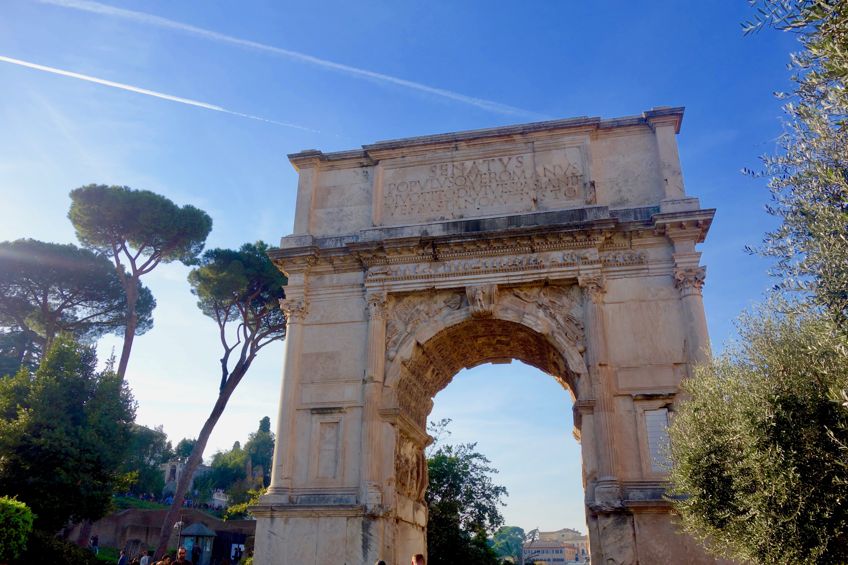 Arch of Titus (81 CE); Sonse, CC BY 2.0, via Wikimedia Commons
Arch of Titus (81 CE); Sonse, CC BY 2.0, via Wikimedia Commons
The Arch of Titus was restored from 1817 to 1821. The restoration was started by Raffaele Stern and ended by Giuseppe Valadier. Perhaps there will one day be a need for additional restoration, but the Arch of Titus remains in Rome to this day.
Thus concludes this discussion of the Arch of Titus. This triumphal arch was created to celebrate and commemorate a great Roman victory but, as befalls all things, it eventually fell into disrepair as time took hold of it. The 1821 restoration has ensured that it continues to influence other architects, but the original structure has long since left us.
Frequently Asked Questions
Why Was the Arch of Titus Built?
The Arch of Titus was built to commemorate the deification of Titus and to record Titus’s conquest over Jerusalem during the Jewish War of 66 to 74 CE.
Who Built the Arch of Titus?
The Arch of Titus was constructed under the order of Emperor Domitian, but was possibly designed by the architect Rabirius. However, a lack of historical records to confirm this means that it is mostly speculative.
When Was the Arch of Titus Built?
The Arch of Titus was built in 81 CE.
What Is the Arch of Titus Inscription?
The Arch of Titus includes two inscriptions: one dedicates the monument to the arch’s namesake, Titus, and the other one was added as part of a restoration in 1821. This new inscription specifically names Pope Pius VII as the one responsible for the restoration.

I am deeply passionate about history and am constantly fascinated by the rich and complex stories of the past. As the editor-in-chief of learning-history.com, I have the opportunity to share this passion with a wide audience through the creation and distribution of engaging and informative content about historical events, persons, and cultures. Whether it’s through writing articles and blog posts or creating videos or podcasts, I strive to bring the past to life in a way that is both accurate and enjoyable. My expertise in history, combined with my strong writing and communication skills, allows me to effectively communicate complex historical concepts and make them accessible and interesting to a wide range of readers. I am truly grateful for the opportunity to share my love of history with others through my work on learning-history.com.


